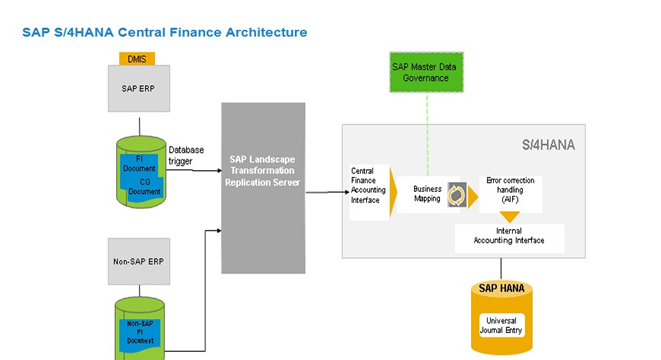Introduction to SAP Central Finance (CFIN) in S/4 HANA.
SAP Central Finance is a module built on top of S/4 HANA which allows the customers to create a common reporting structure by connecting multiple legacy SAP and Non-SAP systems, to a centralized S/4 HANA system. In a nutshell, it is a way to implement S/4 HANA Finance without disrupting the existing ERP systems.
The Central Finance system architecture consists of four processes namely Key Mapping, Value Mapping, Initial Load, and Replication. These processes are important for the proper functioning of CFIN. Also, I have written a separate article discussing in detail about these CFIN Processes.
Table of Contents
SAP Central Finance (CFIN) System Landscape

CFIN system landscape uses 4 different types of systems: Source system, SLT, MDG (Optional), and CFIN.
- The legacy source systems are the ones from which the transaction data flows to the CFIN system. It can be an SAP ECC system, a system already running on S/4 HANA or even Non-SAP ERP systems. Sometimes, organizations can also use the BODS (Business Objects Data Services) system to transition the accounting data flowing from Non-SAP systems to CFIN.
- SAP Landscape Transformation (SLT) Replication System collects the data from the relevant source system tables and stores it into the standard CFIN database tables for further processing. It basically uses a trigger-based replication process to send the data in real-time. The tables used for storing the data are:
- CFIN_ACCHD – Stores the header data of an accounting document.
- CFIN_ACCIT – Stores the line items of an accounting document.
- COBK – Stores the CO documents like cost center allocations.
- AUFK – Stores the cost object replication.
- Master Data Governance (MDG) system can be used to harmonize the master data from the source system to the SAP Central Finance system. SAP recommends it since manual handling of master data mapping can be tedious sometimes. This system will help in the replication of master data elements like GL Accounts, Cost Centers, Profit Centers, Material Codes, Business Partners, etc.
- SAP Central Finance (CFIN) system is where the final posting takes place. Here, you can see the data flowing from source SAP as well as Non-SAP systems. After the data has been pushed from SLT to CFIN, all the documents (either posted successfully or in error) can be viewed in the Application Interface Framework (AIF) tool. CFIN document numbers can be viewed for the documents posted successfully. But for the documents in error, require further analysis to resolve the error.
Who can use it?
- In the case of multiple ERP Systems (SAP or Non-SAP Systems) where the complexity is high.
- Organizations involved in Mergers & Acquisitions.
- In case of common reporting of subsidiaries.
- Organizations doing business in different sectors.
Licenses Required?
- Central Finance
- SAP Landscape Transformation (SLT) Replication Server
- SAP Master Data Governance (MDG), if required.
- SAP BODS (Business Objects Data Services), if required.
Additional Information
If you are interested in doing SAP Central Finance Certification, then you can visit the SAP Central Finance Training portal for more information. The certification cost is Rs. 40000.
The majority of the questions in the certification exam will be related to the Initial Load, Replication, SLT system, MDG system, and CFIN Configuration.
You can also download the SAP Central Finance Configuration PDF for the latest CFIN version 1909 from the SAP CFIN Portal.
Please go through the SAP Documentation for a detailed walk-through. Please leave a comment in case of any queries or suggestions and keep following this blog.



